- Best Multitasking Landmark
- Best Long-Running Arts Retreat and Community Group
- Best Neighborhood Cultivators of Green Space
- Best Student Park Anti-Racism Advocacy
- Best Retirement
- Best Art-Based Rebranding Initiative
- Best Pandemic Isolation Buster
- Best Urban Farm and Tasty Lunch
Many residents of the North Lawndale community area don’t call it that. To them, it’s simply Lawndale, the neighborhood’s original name.
Blanche Killingsworth is a product of Lawndale. She came to the neighborhood from the South in 1962 and has lived there ever since. She currently serves as the chair of the North Lawndale Historical and Cultural Society.
Killingsworth wants the world to know about Lawndale’s rich and storied past. “I talk about North Lawndale everywhere I go,” she said. The Central Park Theater on West Roosevelt Road, for example, was the first of the over fifty theaters in the Balaban and Katz Theater Corporation chain. It was designed by Chicago architectural firm Rapp and Rapp in the Spanish Revival style: a palace of red brick and terra cotta, with forest green roof tiles. The theater opened its doors in the fall of 1917, reportedly the first in the country with mechanical air conditioning.
In its heyday, the Central Park Theater buzzed with the latest in music and film. “Benny Goodman debuted there. Dinah Washington sang there,” Killingsworth said. But it fell into disrepair and shut down in 1969; the House of Prayer—Church of God in Christ took over the building in 1971 and began restoring the building to its former glory. This year, the Central Park Theater was featured in the Chicago Architecture Center’s Open House Chicago virtual tour.
“Cornelius Coffey, the first African American aviator? North Lawndale. Hyman Rickover, the godfather of nuclear submarines? North Lawndale.” Killingsworth chuckled, “Yeah, we’ve got a little history going on that I intend to tell the world about.
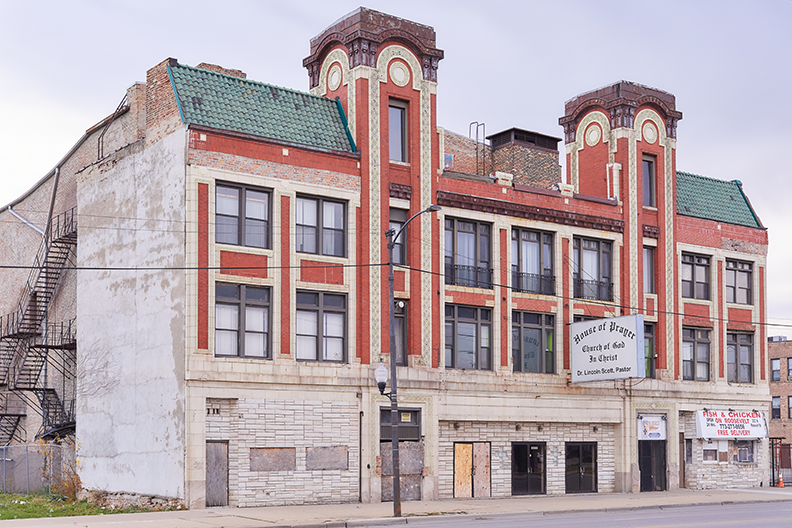
Today, around 34,000 Chicagoans, eighty-eight percent of whom are Black, live in Lawndale. But between 1890 and 1910, it was primarily a Czechoslovakian community. By the 1920s, it had become home to a large Jewish population. In an interview with the Weekly, Killingsworth said that, at one point, the neighborhood had the most synagogues of any place in the city. Chicago’s most famous Jewish commercial street at the time was Roosevelt Road. But white residents left in droves due to racist fear-mongering about precipitous declines in home values as more and more Black families from the South Side and southern states moved to the neighborhood. White flight flipped the neighborhood from white to Black in a decade. According to the Steans Family Foundation, the 87,000 white residents in Lawndale in 1950 dropped to less than 11,000 by 1960, while the Black population grew from 13,000 to more than 113,000.
Lawndale has lost many buildings over the years to fires and uprisings, but above all, to what the Chicago Architecture Foundation’s exhibition guide Learning from North Lawndale: Past, Present + Future calls a “continuous lack of repair” as a result of discriminatory housing policies like contract selling, blockbusting, and landlord-designed overcrowding. In 1993, the city enacted a municipal ordinance called Fast Track to raze vacant buildings. According to the architecture foundation, buildings in Lawndale “became magnets for the wrecking ball.” Fast Track was supposed to improve neighborhoods by demolishing compromised structures and reducing the spaces where sex work and drug use might take place, but instead left communities like Lawndale with piles of rubble and hundreds of vacant lots.
1,355 vacant lots, to be exact, according to the Chicago Data Portal.
While structural disinvestment played a significant role in the story of Lawndale, so did social movements and community-led neighborhood transformation.
Lawndale was where Martin Luther King Jr. lived with his family in 1966 to draw attention to the desperate need for housing reform and an end to discriminatory housing practices in Chicago.
Lawndale was where the Contract Buyers League organized and fought against contract selling, renegotiating hundreds of contracts for its members in the late 1960s and 1970s.
Lawndale was where Gerald and Lorean Earles started the Slum Busters to highlight the beauty of their neighborhood, organizing volunteers to clean up vacant lots and till the soil next to train tracks.
Commitment to Lawndale’s past, present, and future runs deep in this neighborhood’s veins. One of the Lawndale Pop-Up Spot’s most recent exhibitions was “Lawndale: a Living History,” an interactive installation highlighting the portraits and stories of long-time resident Lawndalians to facilitate intergenerational conversations with young folks in the neighborhood. Killingsworth hopes that Chicagoans who don’t live in Lawndale spend time getting to know her neighborhood, “to really see what it is, how it is, and where it’s going—because we are moving.” It is in that spirit that the Weekly has included North Lawndale—more commonly associated with the West Side—in its annual Best of the South Side issue for the first time this year. (Charmaine Runes)
Neighborhood Captain Martha Bayne is the managing editor of the Weekly.
Best Multitasking Landmark
Stone Temple Missionary Baptist Church
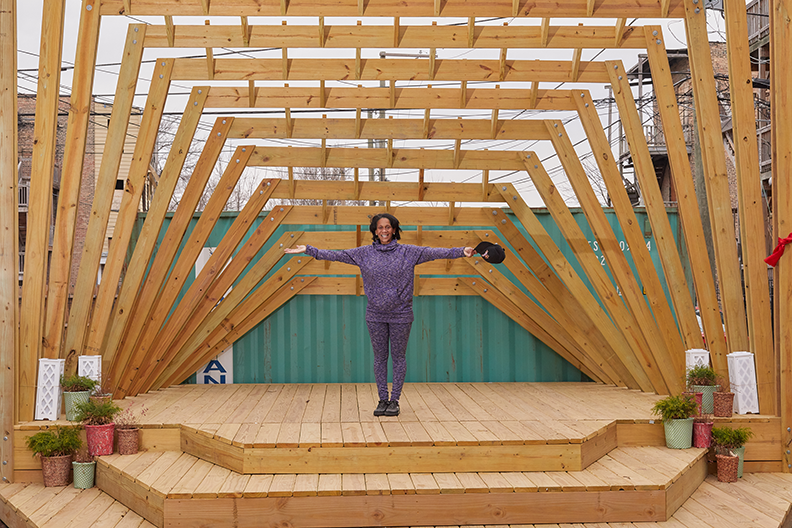
The imposing-if-eclectic structure at the corner of Douglas Boulevard and Millard Avenue has served as a sanctuary to all comers for almost a century. Stone Temple Missionary Baptist Church, designated a landmark in 2016, was established in 1926 as a synagogue by Romanian Jews fleeing persecution. But after, thanks to white flight, Lawndale’s Jewish community left for the suburbs, the building was bought in 1954 by Georgia-born Reverend James Marcellus Stone, and given over to the Baptist church as a haven for Black migrants from the South doing the same. In the fifties and sixties, Martin Luther King Jr., unwelcome in Chicago’s white churches, was a regular preacher, speaking from the pulpit under the glow of stained-glass Stars of David that endure today. “When Dr. King needed someplace to speak in Chicago, because the doors [to white churches] were closed because Mayor Daley said, ‘We don’t need him. He’s a rabble rouser,’ Rev. J.M. Stone, [the church’s founder], allowed him to come here. He set up an office in the church, and was here frequently,” said Reshorna Fitzpatrick; she’s married to Stone’s grandson, Bishop Derrick M. Fitzpatrick, and as a couple they serve as the current pastors.
According to Reshorna, before COVID-19, the church was known as “the funeral church.” A lot of churches are afraid to host funerals for gang members, she said, or simply are too small for large gatherings. So Stone Temple “opened up our doors….anyone who wanted to have a funeral could come here.” She sees this as part of the church’s mission to serve the community, something it’s doing now, under COVID, by hosting outdoor services on the boulevard parkway, and giving away free food—including installing a Love Fridge—and other necessities like diapers and PPE. “We don’t want there to be a lack in our community. We don’t want there to be a lack in the lives of people. Wherever we can be our brother’s keeper, that’s what we want to be. Be it physically, mentally, or emotionally, whatever we can do to help, that’s what we’re really here for.”
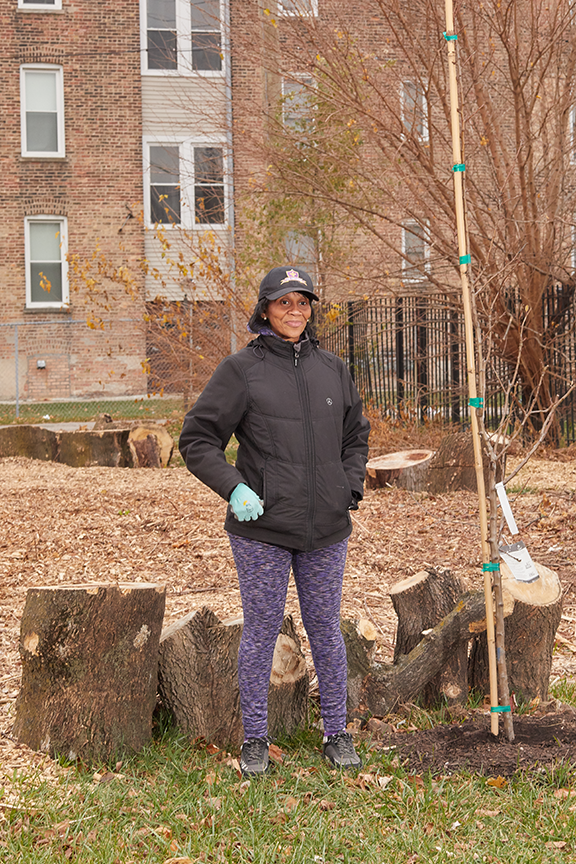
Last year, a flower and vegetable garden was developed just east of the church with the help of Faith in Place, a religious environmental advocacy organization, and volunteers from Chicago Sinai, a Reform Jewish temple on the Near North Side with which Stone Temple has a longstanding partnership. This year, that garden became yet another site of service, with the installation of a stage designed by Human Scale—“a beautiful group of young people” according to Reshorna. The church is currently working with the Goodman Theater to facilitate a seven-week storytelling workshop for anyone in the community who wants to participate. “It gives us a voice to tell our story, our own narrative, our truth, the whole truth and nothing but the truth,” Reshorna said.
This winter, Stone Temple is the distribution site for a free weekly outdoor soup giveaway called “Soup for the Soul. Come next summer, she hopes to see storytelling on the garden stage, and flowers blooming in a new lot across the street, where the church is in the process of installing a cut flower farm and stand called “Love Blooms.” It’s another amenity North Lawndale lacks, and another way Stone Temple is working to fill the gap. (Martha Bayne)
Stone Temple Missionary Baptist Church, 3622 W. Douglas Blvd. (773) 762–0013 or (773) 762-0900. stonetemplechurch.org. Soup for the Soul happens Mondays from 4-6pm through March 31, 2021; for more or to support the project see gofundme.com/f/nlsoupforthesoul.
Best Long-Running Arts Retreat and Community Group
Chicago Urban Art Retreat Center
Looking for ways to be not only involved in your community, but in yourself, through art, workshops, and programs? The Chicago Urban Art Retreat Center (CUARC) puts North Lawndale residents first by offering them a platform to share their creativity.
CUARC is a nonprofit, volunteer-based organization that has been offering arts and cultural programming to residents of North Lawndale since 1991. Over the years, it has created different ways to bring local artists and the community together by offering a safe retreat center where residents can participate in creative workshops, women’s retreats, and much more.
CUARC has incorporated the North Lawndale community into their projects, such as with the North Lawndale Heritage Quilt project, where the theme was the Black heritage of North Lawndale. This community art project consisted of hosting workshops in creating a quilt square with paper, watercolors, collage techniques, and acrylics. In addition to these workshops, several other workshops were held at Sacred Heart Home, a facility for adults with mental and physical health issues. Residents there created portraits of Black Americans that were later included in the quilt.
The center also offers a Peace Art Studio, where community members are invited to make any form of art, with all materials provided. CUARC also encourages participants to examine social justice issues and other issues of concern, such as animal welfare. (The center has made it part of their mission to “be a voice for the voiceless animals that endure cruelty worldwide.”)
CUARC supports North Lawndale youth through its Youth Solutions Program, which encourages nonviolence and peace through art and discussion programs. This program has hosted events such as peace walks, where both children and adults are invited on a short walk promoting peace and happiness. An exciting upcoming project CUARC is currently working on is their Tubman-Kahlo Resource Center. Named in honor of Harriet Tubman and Frida Kahlo, the resource center, to be built on a currently vacant lot at 1957-59 South Kedzie Avenue, near the Kedzie Pink Line stop, will hopefully include an art gallery, a vegan cafe, a meditation garden, a flower shop, a referral office that will offer social services to residents, a stage for performances, and much more. CUARC plans to have this resource center up and running by late 2021 or early 2022. (Valeria Garcia, The Real Chi: Free Spirit Media’s Community Newsroom)
Chicago Urban Art Retreat Center, 1957 S. Spaulding Ave. (773) 542-9126. urbanartretreat.com
Best Neighborhood Cultivators of Green Space
North Lawndale Greening Committee
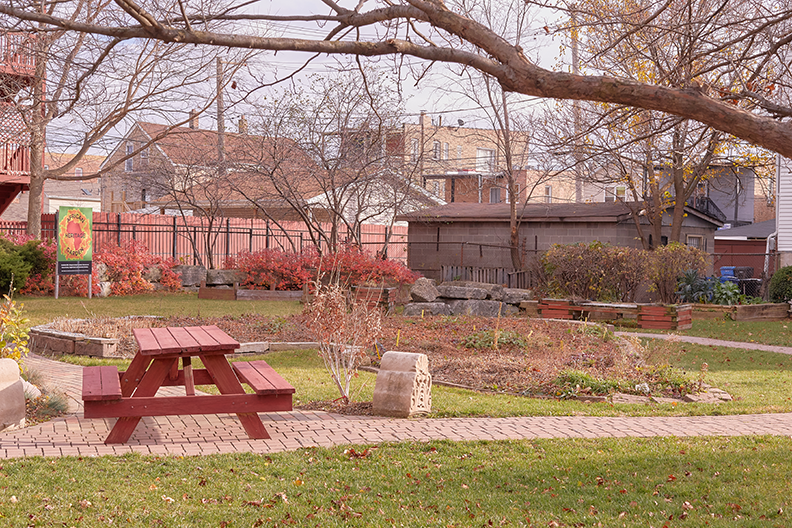
North Lawndale residents have done tremendous work restoring vacant lots into gardens for more than twenty-five years. Over fifty community gardens now dot the neighborhood, all serving a shared purpose beyond beautification: fostering cultural connection.
Each community garden boasts unique features representing the history and pride of its predominantly Black community. The North Lawndale Greening Committee (NLGC) crafted this focus with support and input from the community and city. From the kinds of vegetable beds to the artwork bordering the space, there’s a lot of history under the soil.
Before NLGC formed in 1995, the Slum Busters Garden on the 1900 block of South Trumbull Avenue had been thriving since 1986, created by Gerald and Lorean Earles as part of a campaign to have neighborhood potholes and sidewalks repaired by the city. Their efforts attracted helping hands from both inside and outside the community throughout the years. Located underneath the Pink Line tracks, the garden features flower and vegetable beds and hand-painted signs. In 1993, Slum Busters Garden was conferred a Daily Point of Light Award, given to recognize acts of volunteerism, by then-President Bill Clinton. In the same year, the garden was featured in the movie To Sir with Love, Part 2, starring Sidney Poitier.
This garden, according to NLGC president Dr. Shemuel Israel, inspired other neighborhood renovation and redevelopment projects, including the formation of NLGC and the creation of a local farmer’s market.
A newer garden, African Heritage Garden, at 1245 South Central Park Avenue, sits on four city lots. It has a large flower bed formed in the shape of the African continent containing perennials and annuals whose bold colors evoke those of traditional garments. The Chicago Council of Elders officiated the opening of the African Heritage Garden in 2005 as a place of culture and community, according to its profile on the website of NeighborSpace, a nonprofit urban land trust that works with community gardens throughout the city. It now includes nine raised beds for food production, with trees and shrubs bordering its walls.
Beyond growing food and flowers, the gardens grow community. They have become gathering spaces for storytelling, peace circles, outdoor recess, bird watching, and just leisurely sitting. NLGC also runs a paid summer youth program for teenagers to learn gardening skills to keep cultivating crops during the season. (Madonna Salto, The Real Chi: Free Spirit Media’s Community Newsroom)
For more information on community gardens and gardening in North Lawndale, visit the North Lawndale Greening Committee’s website at nlgreeningcommittee.org
Best Student Park Anti-Racism Advocacy
Campaign to Rename Douglass Park
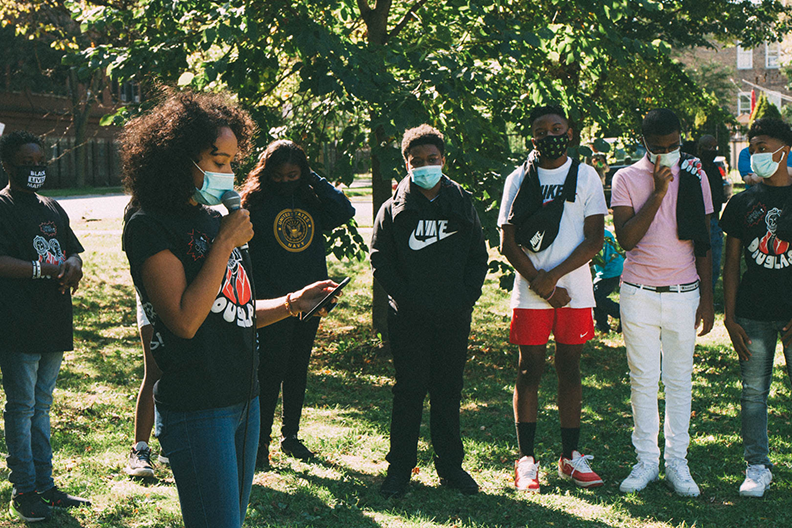
Bianca Jones, a former educator at Village Leadership Academy, had no idea her 2017 fifth graders would create a path forward to dismantling a long legacy of white supremacy. This year, after four years of student advocacy, the Chicago Park District Board of Commissioners made the historic decision to rename Douglas Park in honor of slavery abolitionist Frederick Douglass and his wife, Anna.
“No one anticipated the persistence and the follow-through that these young people were going to have in getting the job done,” Jones said.
For years, the 173-acre park formerly known as “Douglas” has been beloved by the North Lawndale community as a place for kids to play and for families to gather. But it became clear to the students that the park’s original name, honoring former U.S. Senator Stephen A. Douglas of Illinois, best known today for his pre-Civil War debates with Abraham Lincoln in which he refused to condemn slavery, was hurtful to Black Chicagoans who call North Lawndale home.
Village Leadership Academy is a private K-8 school in the South Loop with a social justice focus. “That’s what we wanted—for people to see the damage of white supremacy and our country’s racist past,” said Jennifer Pagán, a former VLA educator who took the lead on the grassroots campaign in 2018 after Jones.
The students initially wanted to rename the park after Rekia Boyd, a young Black woman killed near the park by off-duty Chicago Police Detective Dante Servin in 2012, but later decided to re-focus their campaign in honor of Anna and Frederick Douglass for their efforts in the abolition of slavery and expansion of freedoms for Black Americans. To the students, the historic pair symbolize the passions and struggles of Black Americans in their plight to fight for a more equal future.
“To say that when you step foot on these grounds, this is named after two people who fought for our liberation, it’s small, but there is a mental shift there when you know that history and you know what it means. When that comes up in conversation, that’s empowering, that sows the seeds which spread more knowledge,” Jones said.
These are the same conversations needed to start further empowering Black youth, Black women, and Black families. The renaming of the park is a step forward in that direction, and comes at a time when the nation has slowly begun to wake up to its history and ties with white supremacists.
But Pagán said she believes the class hasn’t been given due credit for its effort, as the students were largely ignored by the city during their four years of canvassing. The name change, said Pagán, has only now happened because city officials felt pressured to do so in the wake of this summer’s protests against the killing of George Floyd. (And perhaps, as reported recently, due to the creative vandalism of two self-described “old white ladies” who, according to a recent WBEZ story, took it upon themselves to add extra “S”’s to the Park District signage.)
However, discouragement and the lack of attention from people in power is no new story for the Black community and other people of color, said Pagán: “This moment definitely was taken advantage of, and the students should have been listened to years ago, but I was glad that they were able to see the fullness of the campaign and able to seal the victory.”
In an impassioned speech celebrating the park’s renaming, Chyla Lockhart, one of the students recently honored with the Friends of the Park Parktivist Award, included advice to young kids inspired to follow in the footsteps of their own work for social justice:“You are powerful! Use your voice and always stay committed. Get the support of your peers and work together even if it’s hard.” (Danyella Wilder)
Douglass Park, W. Roosevelt Rd. to W. 19th St. between S. Albany Ave. and S. California Ave. (773) 762-2842. chicagoparkdistrict.com/parks-facilities/park-no-218-previously-douglas-stephen-park
Best Retirement
New Pine Valley Restaurant
Louise Harper, better known as “Momma Lue,” has been working at New Pine Valley Restaurant since 1962, when she was sixteen, after she moved to Chicago from Mississippi. At age seventy-seven, during her retirement party this September, she could say it was the only employer she ever had. She served meals to generations of Lawndale locals as well as global icons, such as Martin Luther King Jr. and the Clinton family. Momma Lue has been serving some Lawndale neighbors since their childhood and provided others with their first jobs. After a long tenure as a waitress, she purchased the business from the original owners, who were entering retirement—selling her house to be able to do so. Now, Momma Lue is retiring and passing the restaurant along to new owners.
It’s unlikely that longtime customers will notice any major changes to the restaurant, which feels like stepping through a time machine. The original jukebox from the 1960s still operates with the same songs, and the cheeseburgers still cost only $1.35. One thing that’s changed is the cost of an egg sandwich—which has gone up from $2.25 in the 1960s to a ghastly three dollars in 2020.
In a video produced by Free Spirit Media in 2019, Momma Lue said she’s kept her prices low “for the kids—for the North Lawndale kids. They didn’t have enough money!” The neighborhood looked much different when New Pine Valley opened; the area changed demographically a great deal beginning in the 1950s, as Black families like Momma Lue’s moved up from the South, and Lawndale’s white residents fled in racist panic. The 1968 riots following the assassination of Martin Luther King Jr. led to shuttered businesses and municipal disinvestment; more than fifty years later the neighborhood still has few restaurants or other small businesses. King moved to Lawndale in 1966 to protest unfair housing practices and spread his civil rights movement north. New Pine Valley, which proudly served MLK lunch, reminds residents of the storied history that North Lawndale still holds. (Molly O’Mera, The Real Chi: Free Spirit Media’s Community Newsroom)
New Pine Valley Restaurant, 1600 S. Pulaski Rd. (773) 522-5500
Best Art-Based Rebranding Initiative
Art West Chicago

Art West Chicago is on a mission to promote arts and culture by and for the Black community. Covering Austin and Garfield Park as well as Lawndale, Art West created the popular Art West Gallery Tour as a showcase for local creatives, and in October of 2020 they opened a gallery space of their own. The goal is to offer West Siders resources that would’ve otherwise required leaving the neighborhood, and to push back against the image of the West Side as a cultural desert.
“We’ve seen Art West addressing that by providing events or networking opportunities so that we can figure out how to build an ecosystem for the creatives that live here specifically, but also the residents that live on the West Side too,” said Alexie Young, founder of Art West.
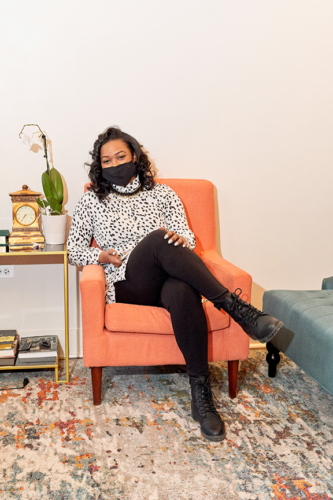
Young, who also manages the MLK Exhibit Center at 1558 South Hamlin Avenue, is a West Side artist herself; her paintings were featured at Art West’s opening gallery show. The opening of the gallery has created new opportunities for Art West to become a creative anchor for the West Side and create a safe space for artists to connect with each other. “Artists who are looking for a network of creatives that they can get connected with,” said Young.
And it’s not just about visual art: Art West supports all forms of creativity, including musicians, graphic designers, and fashion designers and entrepreneurs. “All we need is each other, to help build each other’s brands,” said Young
Given COVID-19 restrictions, Art West is currently activating virtual programming on Instagram and Facebook and has already held online events such as a virtual freedom festival, a seven-day live-streamed music event that included networking opportunities, artist-led workshops, and artist talks. “We had some high-level production and were able to feature over twenty music artists every single day. They performed live at some of the local spaces and all of those performances were streamed online,” said Young of the event.
Other events included virtual gallery tours of community-based artists, creative panels, and workshops such as one on how to make a DIY sugar scrub taught by the owner of Ivy Care, a North Lawndale-based maker of skin care products.
Young said in all she does she’s guided by the question “How do we live, work, and play on the West Side?” With Art West, she’s working hard to provide the answers. (Valeria Garcia, The Real Chi: Free Spirit Media’s Community Newsroom)
Art West Gallery, 750 S. California Ave. artwestchicago.com
Best Pandemic Isolation Buster
Bike Riding
Thanks to few public transit options, Lawndale residents are often already disconnected from the rest of the city, and even from what their own neighborhood has to offer. The pandemic lockdown has isolated some even further. Bike riding is one of the few group activities deemed low-risk for a pandemic, and North Lawndale saw a lot of it this summer.
The Street Love Ride brought together hundreds of West Side cyclists of varying expertise, allowing neighbors a chance to show their community pride as well as safely mingle with their neighbors at the end of a tense and socially distanced summer.
The nine-mile ride occurred on August 15, and was organized by Boxing Out Negativity, a youth mentorship and recreation program that encourages Lawndale youth to use exercise as an outlet. However, many other neighborhood organizations pitched in as well, including Equiticity (a Lawndale community building group), the Lawndale Christian Fitness Center, Ride Illinois, and Working Bikes (Best Bike Oasis, BoSS 2013). Lyft/Divvy also sponsored the event by providing bikes, ensuring every Lawndale resident had a set of wheels who wanted to join in. A second group ride, held October 17, brought more than a hundred cyclists together in the name of environmental justice.
The pandemic shutdown also led to a surge in used bike buying and renting, so much so that at times this summer bikes were hard to come by in Chicago. But Marcus Thorne, executive director of operations for the Young Men’s Educational Network, or YMEN, wanted to make sure his neighbors still had access to wheels. This fall he started a “bike library,” where Lawndale residents can borrow bikes free of charge or have their existing bikes repaired. The library, based in a repurposed shipping container at 13th and Pulaski, offers about twenty bikes, mainly for group rides, and bike repair tutorials from folks at Working Bikes and Equiticity. (Molly O’Mera, The Real Chi: Free Spirit Media’s Community Newsroom)
YMEN Bike Library, W. 13th St. and S. Pulaski Rd.; to arrange to borrow bikes for a group or solo ride call (773) 522-9636.
Best Urban Farm and Tasty Lunch
Farm on Ogden
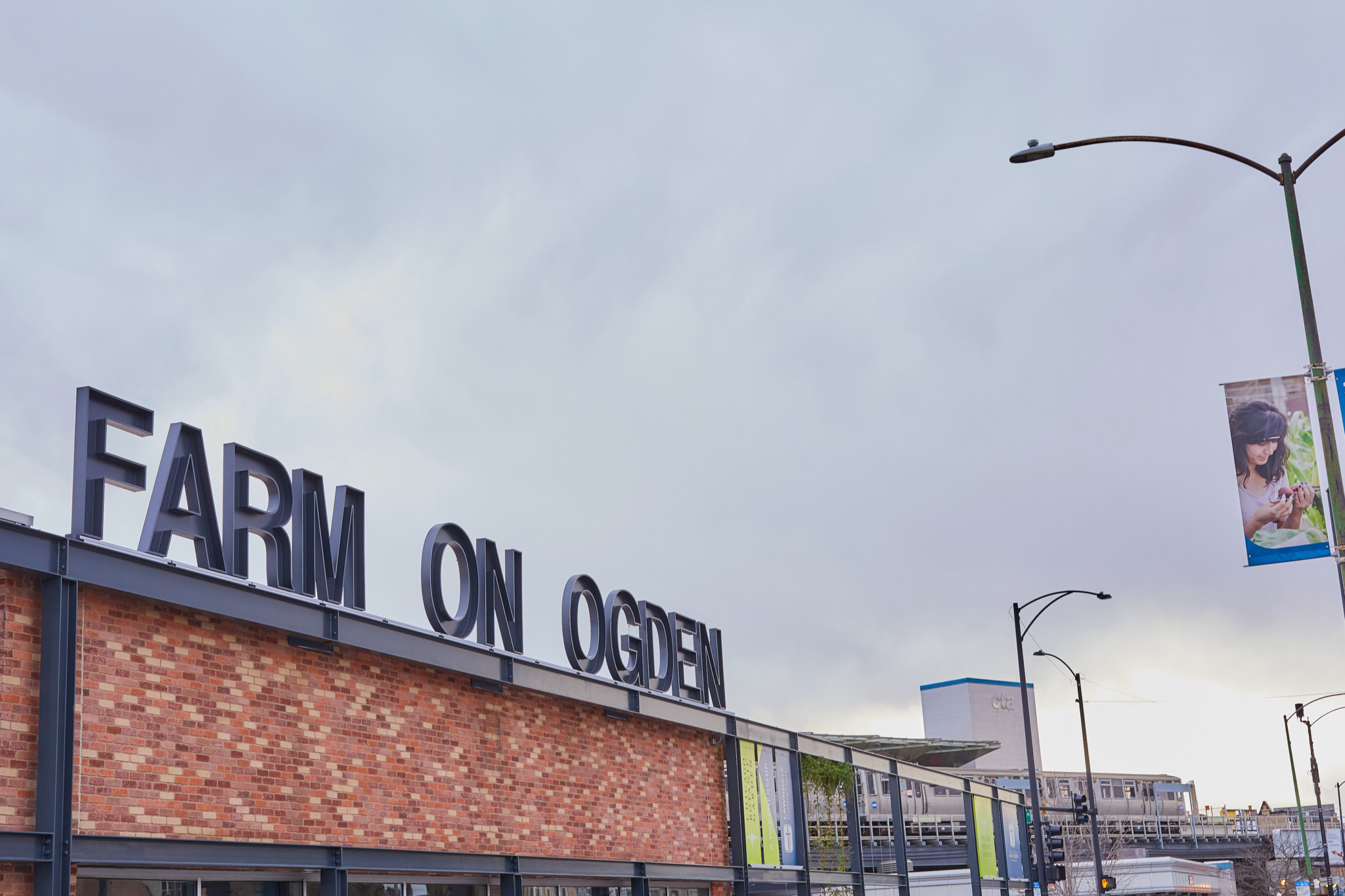
Sitting right next to the Central Park Pink line CTA station, Farm on Ogden is fronted by a retail shop offering onsite and locally grown produce, tilapia, some dry goods, and fantastic to-go sandwiches and salads for lunch. This Chicago Botanic Garden project is in partnership with Lawndale Christian Health Center, focusing on job training, wellness, food, and health. The old bow-truss building that houses the farm is also a learning center with a flexible layout for classroom and meeting spaces, and has an attached commercial kitchen.
Tours of the facility, usually held on Saturdays and for discounted rates for nearby residents, are currently on hold, but when they return will offer the chance to see the aquaponics farm where workers and volunteers raise fish and recycle the water to grow produce. Part of the partnership with Lawndale Christian is a “Veggie RX” program, in which patients receive a “prescription” for veggie packages and can participate in cooking classes as well, part of an innovative initiative promoting healthy eating known as “food as medicine.”
The Farm on Ogden is also home to the offices of Windy City Harvest (WCH), which runs seventeen farms on eight acres throughout the city. For over a decade, WCH has offered workshops, classes, and certificate programs in urban agriculture, as well as workforce development, offering paid employment through a youth farm corps and an apprenticeship program through City Colleges of Chicago.
While tours are on hold, it’s still possible to get a glimpse of the aquarium action inside: hang out on the sidewalk and peer through the windows, and you can watch the tilapia swimming in the tanks. (Jon Brown)
Farm on Ogden, 3555 S. Ogden Ave. Fresh Market open Thursday, noon–6pm; and Friday–Saturday, 11am-5pm. (847) 835-6807. chicagobotanic.org/urbanagriculture/farm_on_ogden

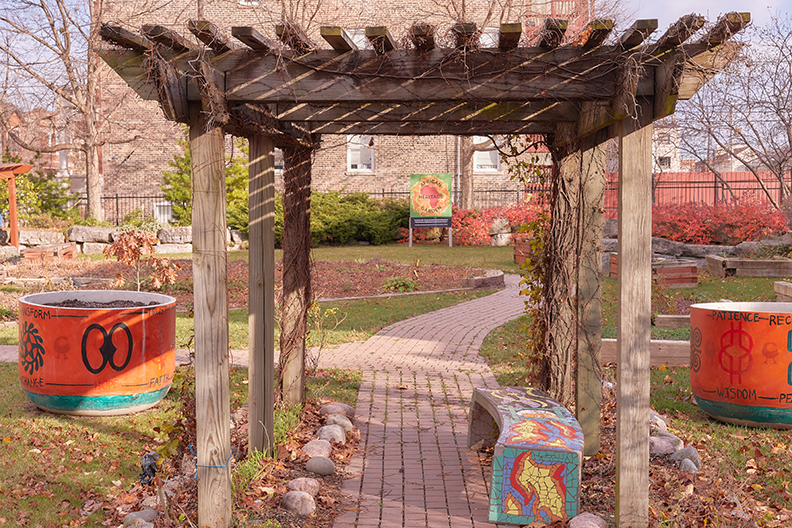
Chicago has been on my mind lately. I live in southern California now, but I was born and raised in Chicago on the west side on Douglass Blvd. I started school at Victor F. Lawson School (now demolished, off 13th Place) and later transferred to Julia C. Lathrop on Christiana before moving to the south side. My best kid years were in that era, the 1960s. My dad was a 24th Ward precinct captain. That ward bought so much joy to us kids at Halloween and Christmas time, putting on special shows at Central Park Theatre with cartoons and prize drawings from small toys to wagon and bikes. We all left with a net bag full of candies and fruit. They even had fleets of Willet school buses take us to Riverview one summer! Stressful times those 60s, but as a child I found fun at the pool, a day camp at St. Agatha, and teachers that would not give up on us at Lathrop and Lawson. Sears was our Christmas treat! Before I leave the earth, I hope to give back what I’ve learned to the kids of Lawndale. I bet some of them would get a kick out of launching a model rocket 🙂